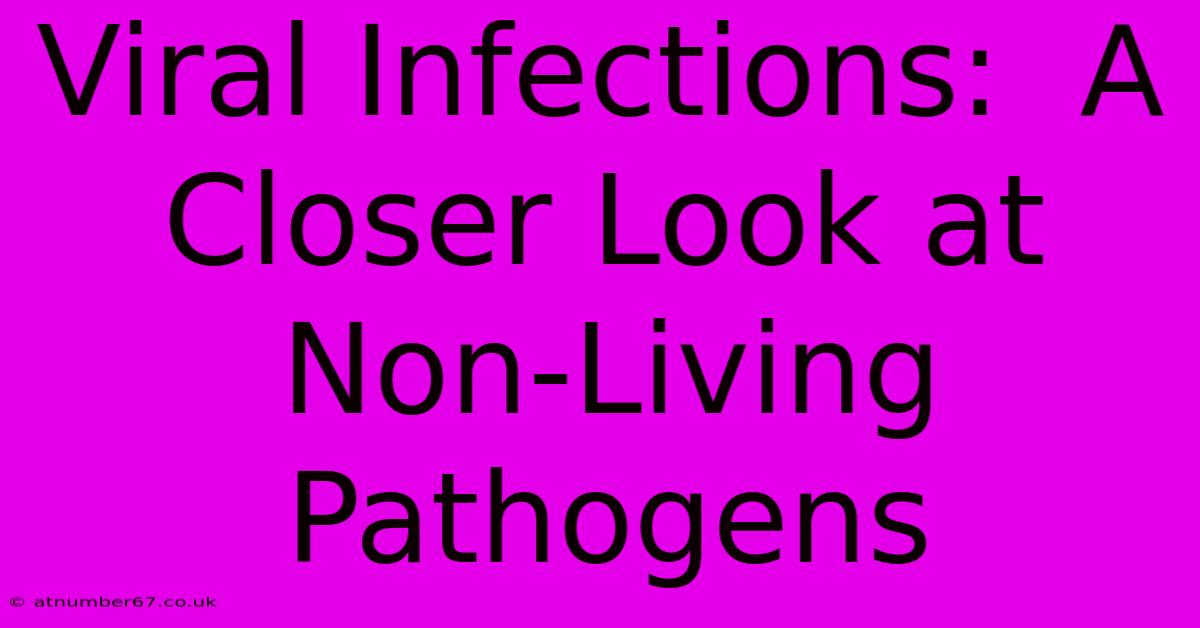Viral Infections: A Closer Look At Non-Living Pathogens

Table of Contents
Viral Infections: A Closer Look at Non-Living Pathogens
Viral infections are incredibly common, impacting everyone from infants to the elderly. Understanding these infections requires acknowledging a crucial detail: viruses aren't technically alive. This seemingly simple fact significantly shapes how they behave, replicate, and are treated. Let's delve deeper into the fascinating world of these non-living pathogens.
What Makes Viruses Non-Living?
Unlike bacteria, fungi, or parasites (all considered living organisms), viruses lack the cellular machinery necessary for independent life. They are essentially genetic material (DNA or RNA) encased in a protein coat, sometimes with a lipid envelope. This means they can't:
- Replicate on their own: Viruses are obligate intracellular parasites, meaning they must invade a host cell to reproduce. They hijack the host cell's machinery to create copies of themselves.
- Produce their own energy: They lack the metabolic pathways to generate energy. Instead, they rely entirely on the host cell for resources.
- Maintain homeostasis: They don't regulate their internal environment.
- Respond to stimuli: They don't react to external changes in the same way living organisms do.
How Viruses Cause Infection
The viral infection process typically involves several steps:
- Attachment: The virus binds to specific receptors on the surface of the host cell. This explains why some viruses only infect certain types of cells (e.g., HIV infecting immune cells).
- Entry: The virus enters the host cell, either by fusing with the cell membrane or being engulfed by the cell.
- Replication: The virus uses the host cell's machinery to replicate its genetic material and produce viral proteins.
- Assembly: New viral particles are assembled from the replicated genetic material and proteins.
- Release: Newly formed viruses are released from the host cell, often destroying the cell in the process. This released virus can then infect other cells, continuing the cycle.
Types of Viral Infections
Viral infections span a vast spectrum of severity, from mild, self-limiting illnesses to life-threatening diseases. Some common examples include:
- The Common Cold: Caused by rhinoviruses and other viruses, leading to mild upper respiratory symptoms.
- Influenza (Flu): Caused by influenza viruses, characterized by fever, cough, and muscle aches.
- Measles, Mumps, and Rubella: Highly contagious childhood diseases, preventable through vaccination.
- Chickenpox: A highly contagious viral infection causing a characteristic itchy rash.
- Human Immunodeficiency Virus (HIV): A retrovirus that attacks the immune system, leading to AIDS if left untreated.
- Coronavirus: This family of viruses includes SARS-CoV-2, the cause of COVID-19. Coronavirus infections can range from mild to severe respiratory illness.
Treatment and Prevention
Treatment for viral infections often focuses on managing symptoms and supporting the body's immune response. Antiviral drugs can be effective in some cases, particularly for certain serious viral infections like HIV and influenza. However, antibiotics are ineffective against viruses.
Prevention plays a crucial role in controlling the spread of viral infections. Key strategies include:
- Vaccination: Vaccines are a powerful tool for preventing many viral infections.
- Hygiene: Frequent handwashing and covering coughs and sneezes can significantly reduce transmission.
- Isolation: Isolating infected individuals can help prevent the spread of highly contagious viruses.
The Ongoing Battle Against Viruses
The ever-evolving nature of viruses poses a continuous challenge. Viruses mutate frequently, making it difficult to develop long-lasting immunity and effective treatments. Research into antiviral therapies and vaccine development is crucial in our ongoing battle against these non-living invaders. Understanding the unique characteristics of viruses—their non-living nature and obligate intracellular parasitism—is fundamental to developing effective strategies for prevention and treatment.

Thank you for visiting our website wich cover about Viral Infections: A Closer Look At Non-Living Pathogens. We hope the information provided has been useful to you. Feel free to contact us if you have any questions or need further assistance. See you next time and dont miss to bookmark.
Featured Posts
-
Alevilere Hakaret A Deeper Dive
Apr 03, 2025
-
Pinky Dhaliwals Son The Future Is Bright
Apr 03, 2025
-
The Lio Son Fils Advantage You Wont Believe This
Apr 03, 2025
-
Emmy Rossums Daughter A Growing Inspiration
Apr 03, 2025
-
Seyi Tinubu Net Worth And His Philanthropic Efforts
Apr 03, 2025
